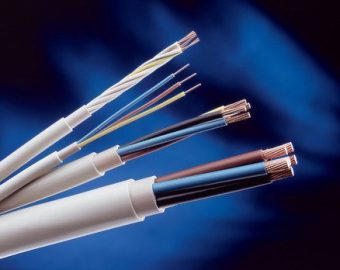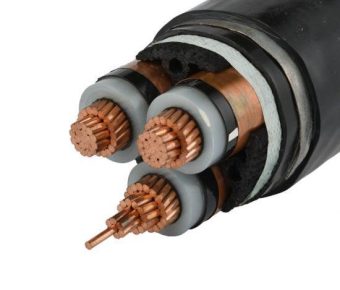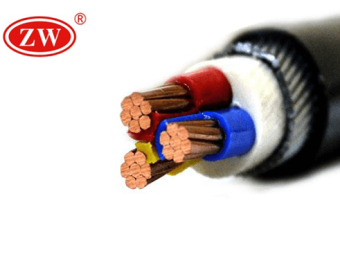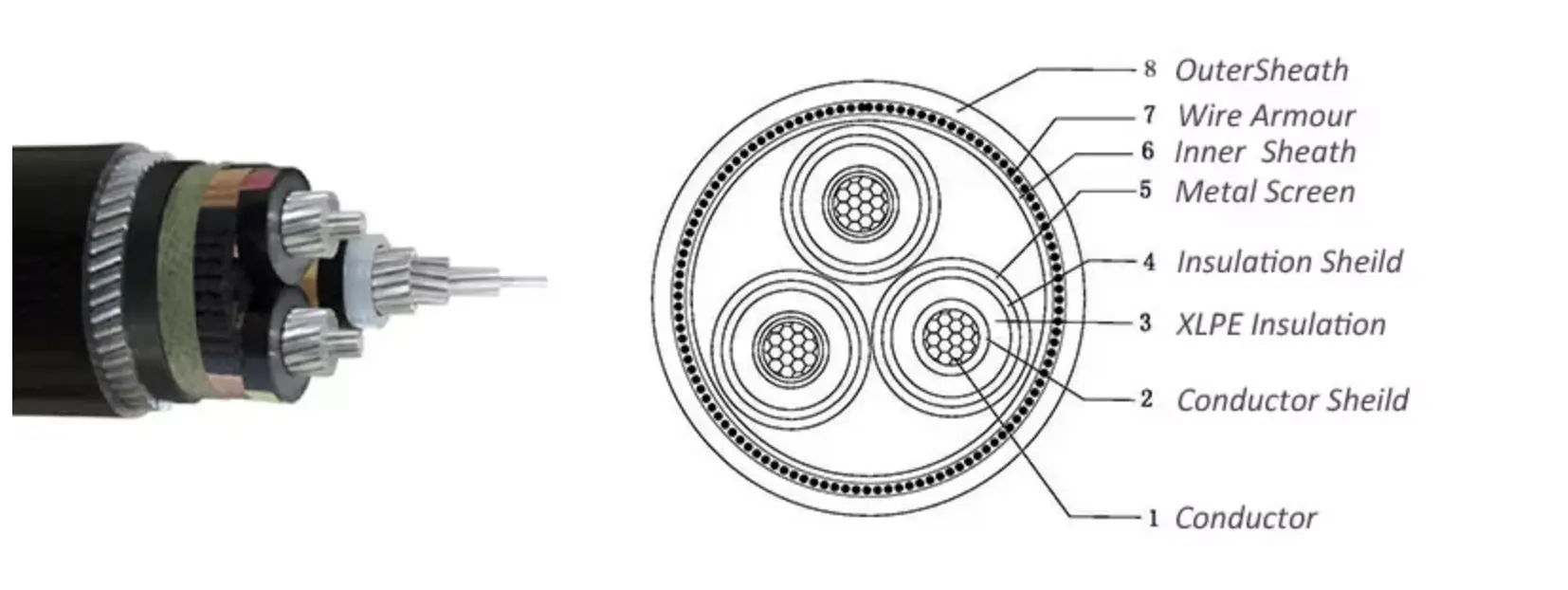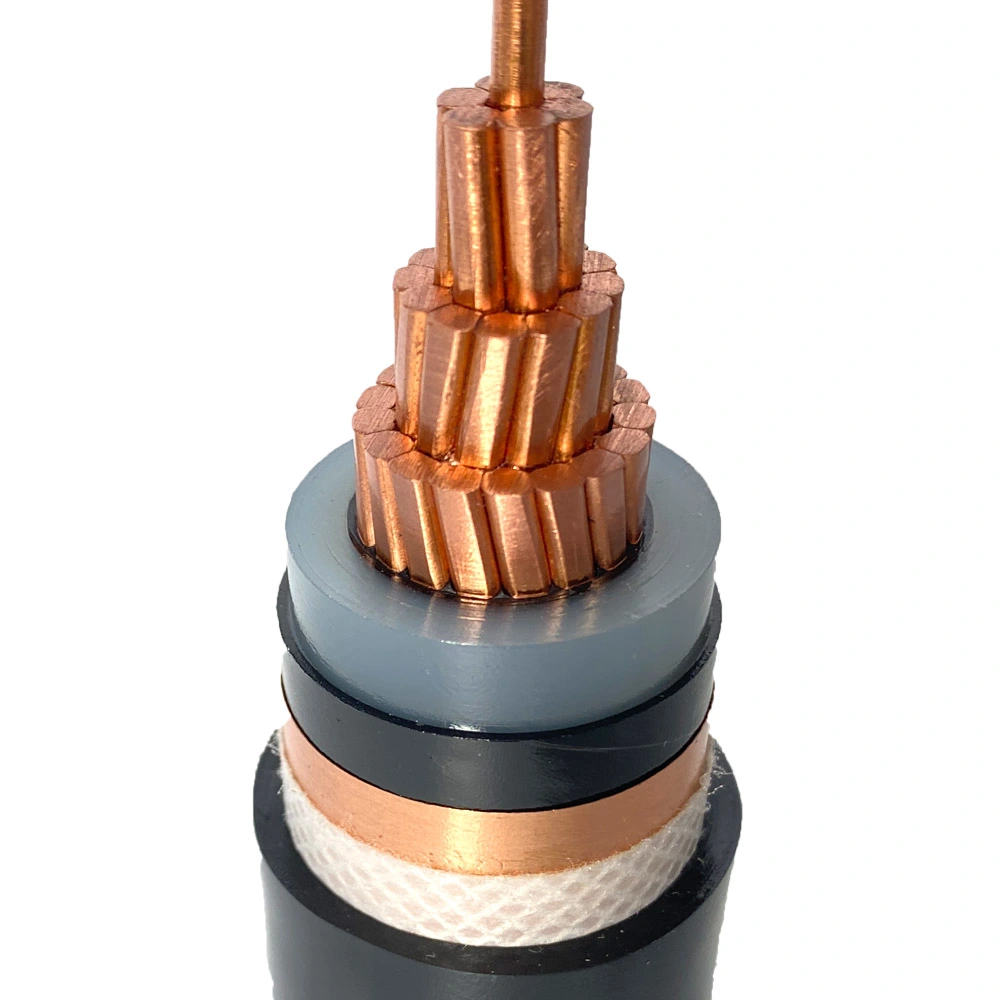HV Cable
- According to IEC and GB Standard
- PVC Cable
- Approved by ISO, BV,Sgs
- Large stock hv cables with different sizes
The components of a hv cable from the inside out include conductor, insulation, inner sheath, filling material (armoring), and outer insulation. Hv cable is mainly used for underground burial, where they can resist high-intensity compression on the ground and at the same time prevent damage from other external forces.
Conductor: Copper Or Aluminum
Insulation: Cross-linked polyethylene (XLPE)
Filler: Polypropylene filament with lapped binding tape
Binder: Binding tape
Inner sheath: Polyvinyl chloride (PVC)
Amour: Steel wire armored(SWA) or steel tape armored(STA)
Sheath: Polyvinyl chloride (PVC)
Rated voltage (kv) Sectional area (mm2) No. of core | 1st class | 0.6/1 | 1.8/3 | 3.6/6 | 6/10 | 8.7/15 | 12/20 | 18/30 | 21/35 |
2nd class | 1/1 | 3/3 | 6/6 | 8.7/10 | 12/15 | 18/20 | – | 26/35 | |
1 Core | 1.5-800 | 25-800 | 25-1200 | 25-1200 | 35-1200 | 50-1200 | 50-1200 | 50-1200 | |
2 Core | 1.5-185 | 25-185 | |||||||
3 Core | 1.5-400 | 25-400 | 25-400 | 25-400 | 35-400 | 50-400 | 50-400 | 50-400 |
Table of Contents
HV Cable: 5 Crucial Specifications To Consider When Buying
Distinctly, the realization of any sort of development globally is attributable to an efficient electricity supply. High voltage cable manufacturers and hv cable suppliers play a crucial role in electrical cable. They have ensured that electricity use is worldwide. A high voltage wire transmits electrical power at very high voltage levels.
High voltage cables aid in the distribution of power to remote areas. Moreover, they serve as the backbone of many megacities throughout the world. Hv wire gives a constant supply of power. The world’s largest hv cable manufacturers have maintained constant support systems.
HV Cable Specification
1. What Is an HV Cable?
A high-voltage cable (hv cable) features a high-voltage electric power transmission. Hv cable consists of a conductor and an insulator. There are single core and 3 core hv cables, but most high voltage cables are armoured. Usually, we use steel tape armoured or steel wire armoured.
The purpose of hv cables insulation is to prevent degrade in any application. This owes to a high-voltage stress creation by electric discharges in the air or tracking. Also, the high-voltage conductor must stay safe from coming into contact with items.
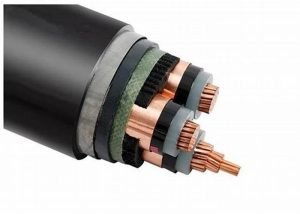
Leading Cable and Wire Manufacturer-ZW Page High Voltage Cable According to
An extra high voltage cables are applicable in various fields. This includes AC and DC power transmission. Also, ignition systems use this extra high voltage wire.
Additionally, the hv cable design contains and regulates current leakage. Another special area where the hv cable is useful is to prevent insulation breakdown. Usually, cable couplings and terminals are able to handle high-voltage stress.
A high-voltage cable’s basic design comprises several elements. They include the conductor, the conductor shield, the insulator, and the insulating materials shield. The other components include the metallic shield and the jacket.
Layers such as rip cords, armor wires, and adhesives are also possible. Polymers are best for insulation, insulation shielding, and conductor shielding.
Usually, copper or aluminum covers the high voltage shielded cable. A metallic shield generates an earth layer for draining any leakage that may be present.
The jacket of the xlpe hv cable is often made of polymer. Its purpose is to shield the wearer from harmful elements. These elements may include dampness and chemicals. The jacket also offers protection against accidental impact.
The jacket can act as semi-conducting or non-conducting. This depends on the characteristics of the soil. It also depends on the arrangement of the high-voltage grounding cable. Semi-conducting jackets are useful while testing HV cables jacket’s integrity.
An hv cable construction, especially for hv underground cable, must meet particular requirements. First, the cables conductor should be high conductor copper or aluminum. Stranding makes the conductor more flexible and capable of carrying greater current.
Second, the hv cable size should carry the appropriate load current without overheating. It should also have a voltage drop that is within acceptable norms. Third, the HV lv cables must have enough insulation thickness. This is necessary to provide an enough level of safety.
The hv cable also needs mechanical protection to resist rigorous handling during installation. Finally, the cables components should be chemical and physical stable throughout.
High voltage single core cables are generally ideal for use in several areas. Some of the application fields includes installation in power supply stations.
Other uses include cable ducts, outdoors, and underground. Cable trays for factories, switchboards, and power stations also use this cable. High voltage grounding cables helps in power distribution with a nominal voltage of 64/110kV.
2. What Is the Voltage Range of The HV Cable?
Typically, a hv-cable has a voltage range exceeding 1000 volts. Those between 2 kV and 33 kV are often referred to as medium voltage cables. While those above 50 kV are high voltage cables.
High-voltage cables are rigorously tested for their effectiveness. They can help in transmitting power for over a total distance of over 600,000 kilometers of roadways. They fulfill all electrical, thermal, and mechanical requirements with exceptional adequacy.
It is necessary to perform an hv cable test. Rationale is that it aids in the prediction and prevention of problems before they occur. Most of system issues are difficult to recognize by unlicensed specialist.
3. Difference between MV cable and HV cable
It is worth noting that heavy applications use medium and high voltage. In this scenario, the greater voltage enables the use of smaller cables. As a result, there is reduction in the expenses associated with distribution cables.
Professionals who operate with big loads find that medium and high-voltage motors helpful. But there are differences between the medium- and high-voltage cables as follows:
hv cable can handle between 100 and 345 kV, while MV-cable can manage voltage of up to 100 kV.
A high-voltage cable is a cable that transmits high-voltage electricity. Usually, a cable has a conductor and something to protect it. On the other side, medium voltage is useful in major industrial complexes. Medium voltage cable is also helpful in enterprises demanding medium quantity of electricity.
You may be interested in Medium Voltage Cable: A New Standard In Power Transmission
The high voltage power cable is unique. They function with certain switching and transmission panels. In contrast, medium voltage cables are necessary for emergency scenarios.
Another difference is in the feature of their semi-conductors. The semi conducting layers in hv electrical cables must be continuous. The layers also need to be a few micrometers thick.
Any fission or gap between the layers’ fusion and insulation might be hazardous. But in the medium voltage cable, semi-conductors are partly attached to the insulation. They are often utilized to ensure the creation of connections with little effort.
4. Difference Between HV And LV Cables
The transfer of high voltage requires hv wire. This is most often seen in power stations and transformers. It ranges from 33 kV up to 220 kV. The majority of their work is done on electricity grids.
In contrast, LV cables are usually applicable in domestic and light industrial applications. It may be as low as 70V or as high as 600V.
Also Read: 0.6/1KV Low Voltage Cable
A wide variety of automation technologies and industries use low voltage cables. Them since they are enough to fulfill the operating requirements of machines.
High cable is useful in transmitting power. But low voltage cable cables are helpful in sending control signals. This is one interpretation of the relationship between the two. In any event, any living thing should not come into contact with these live wires since doing so might be fatal.
The hv cables are quite effective at increasing efficiency. Due to the high voltages, the hv cable insulation has to be robust. High voltage cables feature a thick layer of insulating protection. This contributes to the high transmission mode.
In contrast, low voltage cables are effective at carrying lower voltage. Power transformers use low voltage cables to provide a consistent and dependable voltage. This is suitable for residential and commercial needs. Low voltage cables play an essential role in passing low voltage levels.
High-voltage cables have round conductors to improve heat dissipation. But lv cables may have nonstandard conductor shapes. These shapes may be in form of include tiles, fans, and semicircles to save costs.
The conductor of a low-voltage cable may compose of copper or aluminum. But, the conductor of a high-voltage cable is more likely to be copper.
4. What Is the Maximum Voltage That Hv Cables Can Carry?
HV Cable can carry the largest power of 350 kV. The purpose of electricity transmission at high voltages is to improve effectiveness. Studies show that whenever electricity moves across vast distances, some energy is lost.
When electricity moves from one site to another, the amount of power reduces. This usually happens when using high voltage transmission. This is because the current flows at a slower rate as the voltage increases.
If the current is reducing, the resistance losses decrease. In other words, if resistance losses decrease, energy losses are also kept to the least. Thus, when selecting the ideal transmission voltage, electrical engineers consider several parameters. These include factors include including the amount of power and the distance.
High voltage transmission is helpful from a technical standpoint. High voltage transmission has less resistance in the conductors. This is usually due to the lower current that comes with it. As a result, transmission across great distances is achievable using lightweight, narrow-gauge wires.
This means that high current does not need transmission towers to accommodate the extra weight of larger cables. These factors make long-distance high-voltage transmission less expensive.
5. Conclusion
A hv power cable has a voltage rating of more than 1,000 volts. An hv cable may have one or several conductors. Power transmission often makes use of high-voltage cables. Delivery of electricity across vast distances uses high voltage transmission lines.
The high voltage is essential to decrease energy loss over the distance. High voltage cables are crucial since electricity is not storable while not in use.
The expanding market for renewable energy sources has played a significant role. It has introduced increasing demand for high-voltage cables in recent years. As a result, the need for hv cable continues to increase.

